window Alfa Romeo 156 2007 Owner handbook (in English)
[x] Cancel search | Manufacturer: ALFA ROMEO, Model Year: 2007, Model line: 156, Model: Alfa Romeo 156 2007Pages: 357, PDF Size: 5.04 MB
Page 134 of 357
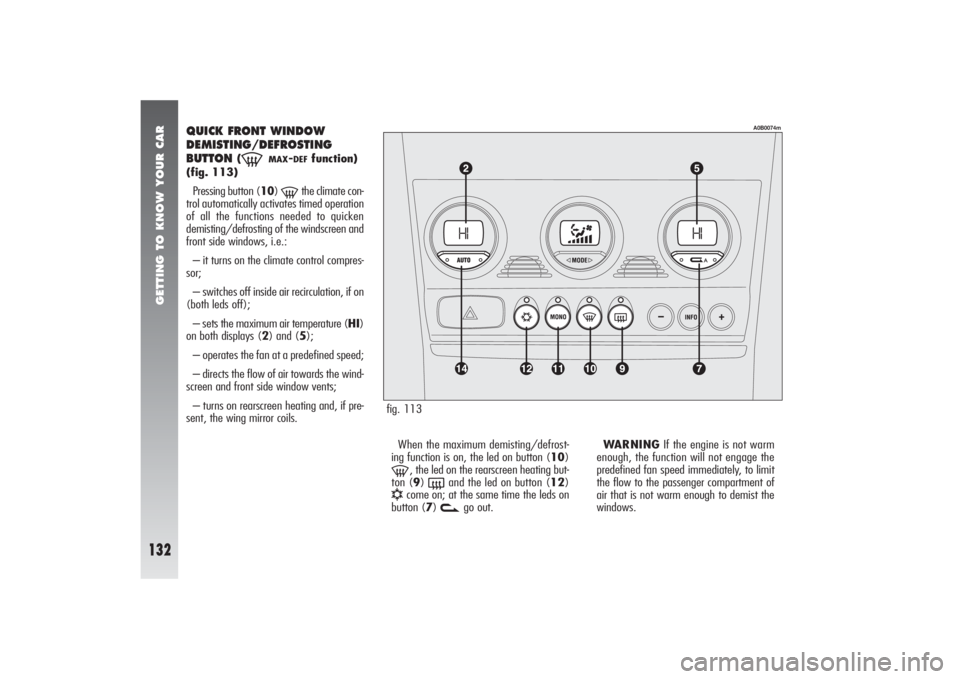
GETTING TO KNOW YOUR CAR
132
fig. 113
A0B0074m
QUICK FRONT WINDOW
DEMISTING/DEFROSTING
BUTTON
(-
MAX
-DEF
function)
(fig. 113)
Pressing button (10)
-
the climate con-
trol automatically activates timed operation
of all the functions needed to quicken
demisting/defrosting of the windscreen and
front side windows, i.e.:
– it turns on the climate control compres-
sor;
– switches off inside air recirculation, if on
(both leds off);
– sets the maximum air temperature (HI)
on both displays (2) and (5);
– operates the fan at a predefined speed;
– directs the flow of air towards the wind-
screen and front side window vents;
– turns on rearscreen heating and, if pre-
sent, the wing mirror coils.
When the maximum demisting/defrost-
ing function is on, the led on button (10)
-
, the led on the rearscreen heating but-
ton (9)
(
and the led on button (12)
√
come on; at the same time the leds on
button (7)
v
go out.WARNINGIf the engine is not warm
enough, the function will not engage the
predefined fan speed immediately, to limit
the flow to the passenger compartment of
air that is not warm enough to demist the
windows.
Page 135 of 357

GETTING TO KNOW YOUR CAR
133
When the maximum demisting/defrost-
ing function is on, the only manual opera-
tions possible are manual adjustment of the
fan and switching rearscreen heating off.
Pressing one of the following buttons:
(10)
-
, (7)
v
, (11)
MONO
, (14)
AUTO
or (12)
√
the system switches off
the maximum demisting/defrosting func-
tion, resuming the system operating condi-
tions prior to turning it on, in addition to
activating the last function required, if any.
WING MIRROR AND
REARSCREEN DEFROSTING/
DEMISTING BUTTON
(
(fig. 114)
Pressing button (9)
(
, turns on demist-
ing/defrosting of the rearscreen and, if pre-
sent, the wing mirror coils.
The activation of this function is shown
by the turning on of the led on the button.
This function is timed and switches off au-
tomatically after 20 minutes, or pressing the
button again; the function is also switched
off when the engine is stopped and will not
be switched on again the next time the en-
gine is started.WARNING Rear heated window man-
ual on/off control prevails over automatic
activation decided by the climate control sys-
tem control unit.
fig. 114
A0B0075m
Page 136 of 357

GETTING TO KNOW YOUR CAR
134
This function is timed and switches off au-
tomatically after 20 minutes, or pressing the
button again; the function is also switched
off when the engine is stopped and will not
be switched on again the next time the en-
gine is started.
WARNINGThe system turns on
rearscreen heating automatically if the tem-
perature is below 3°C.
WARNINGDo not apply stickers on the
inside of the rearscreen over the heating fil-
aments to avoid damage that might cause
it to stop working properly.
WARNINGWhen reconnecting the neg-
ative battery cable after having disconnected
it, wait for 2 minutes before turning the key
to enable the climate control system to re-
set actuator strokes properly.
POLLEN FILTER This filter has the specific capability of com-
bining the mechanical filtering of the air with
an electrostatic effect so that the outside air
admitted to the passenger compartment is
purified and free from particles such as dust,
pollen, etc.
In addition to the above, it also effectively
reduces the concentration of pollutants.
The filtering action takes place under all
air inlet conditions and it is clearly most ef-
fective with the windows shut.
Have the conditions of the filter checked by
Alfa Romeo Authorized Services at least once
a year, preferably on the onset of summer.If the vehicle is used mainly in polluted
or dusty areas it should be checked and if
necessary replaced, at shorter intervals.
Failure to replace the fil-
ter may considerably re-
duce the effectiveness of
the climate control system up to
blocking the air flow from the out-
lets and vents.
Page 186 of 357
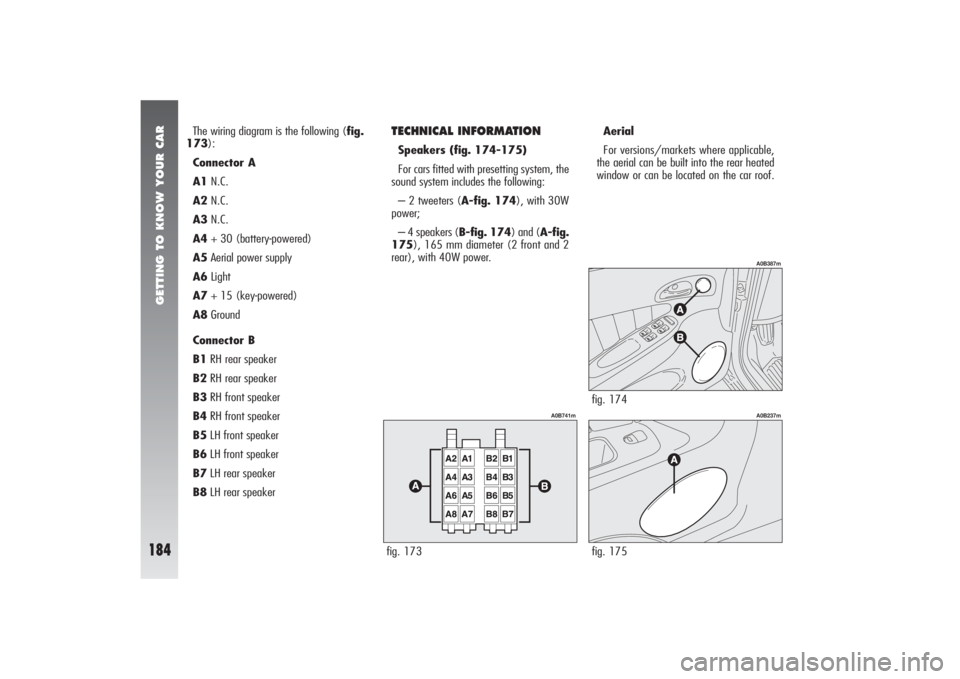
GETTING TO KNOW YOUR CAR
184
The wiring diagram is the following (fig.
173):
Connector A
A1N.C.
A2N.C.
A3N.C.
A4+ 30 (battery-powered)
A5Aerial power supply
A6Light
A7+ 15 (key-powered)
A8Ground
Connector B
B1RH rear speaker
B2RH rear speaker
B3RH front speaker
B4RH front speaker
B5LH front speaker
B6LH front speaker
B7LH rear speaker
B8LH rear speaker
TECHNICAL INFORMATIONSpeakers (fig. 174-175)
For cars fitted with presetting system, the
sound system includes the following:
– 2 tweeters (A-fig. 174), with 30W
power;
– 4 speakers (B-fig. 174) and (A-fig.
175), 165 mm diameter (2 front and 2
rear), with 40W power.Aerial
For versions/markets where applicable,
the aerial can be built into the rear heated
window or can be located on the car roof.fig. 173
A0B741m
fig. 174
A0B387m
fig. 175
A0B237m
Page 198 of 357
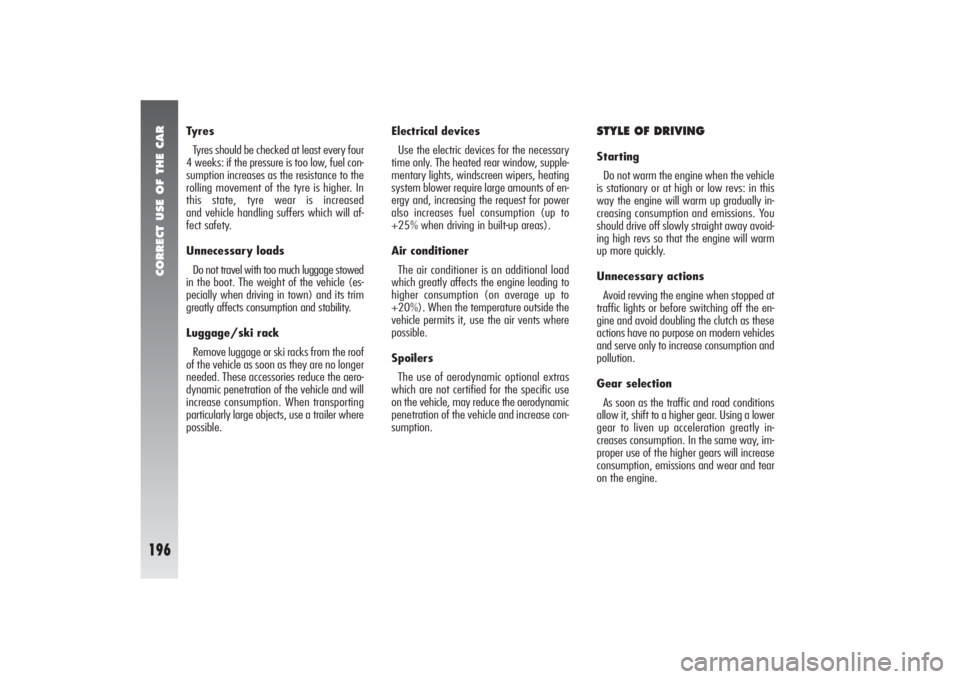
CORRECT USE OF THE CAR
196
Tyres
Tyres should be checked at least every four
4 weeks: if the pressure is too low, fuel con-
sumption increases as the resistance to the
rolling movement of the tyre is higher. In
this state, tyre wear is increased
and vehicle handling suffers which will af-
fect safety.
Unnecessary loads
Do not travel with too much luggage stowed
in the boot. The weight of the vehicle (es-
pecially when driving in town) and its trim
greatly affects consumption and stability.
Luggage/ski rack
Remove luggage or ski racks from the roof
of the vehicle as soon as they are no longer
needed. These accessories reduce the aero-
dynamic penetration of the vehicle and will
increase consumption. When transporting
particularly large objects, use a trailer where
possible.Electrical devices
Use the electric devices for the necessary
time only. The heated rear window, supple-
mentary lights, windscreen wipers, heating
system blower require large amounts of en-
ergy and, increasing the request for power
also increases fuel consumption (up to
+25% when driving in built-up areas).
Air conditioner
The air conditioner is an additional load
which greatly affects the engine leading to
higher consumption (on average up to
+20%). When the temperature outside the
vehicle permits it, use the air vents where
possible.
Spoilers
The use of aerodynamic optional extras
which are not certified for the specific use
on the vehicle, may reduce the aerodynamic
penetration of the vehicle and increase con-
sumption.
STYLE OF DRIVINGStarting
Do not warm the engine when the vehicle
is stationary or at high or low revs: in this
way the engine will warm up gradually in-
creasing consumption and emissions. You
should drive off slowly straight away avoid-
ing high revs so that the engine will warm
up more quickly.
Unnecessary actions
Avoid revving the engine when stopped at
traffic lights or before switching off the en-
gine and avoid doubling the clutch as these
actions have no purpose on modern vehicles
and serve only to increase consumption and
pollution.
Gear selection
As soon as the traffic and road conditions
allow it, shift to a higher gear. Using a lower
gear to liven up acceleration greatly in-
creases consumption. In the same way, im-
proper use of the higher gears will increase
consumption, emissions and wear and tear
on the engine.
Page 205 of 357

CORRECT USE OF THE CAR
203
Keep your speed
down when snow
chains are fitted.
Do not exceed 50 km/h. Avoid
potholes, steps and pavements and
avoid also to drive for long dis-
tances on roads not covered with
snow to prevent damaging the car
and the roadbed.
VEHICLE INACTIVITYIf the car is to be left inactive for long pe-
riods, the following precautions should be
noted:
– House the vehicle under cover in a dry
and possibly ventilated place.
– Engage a gear.
– Check that the handbrake is not en-
gaged.
– Clean and protect the painted parts us-
ing protective wax.
– Disconnect the negative terminal (–)
and check the battery charge. This check is
to be repeated every three months.
Recharge if the optical indicator shows a
dark colour without the central green area.
WARNINGWhere applicable, switch off
the electronic car alarm with the remote con-
trol.– Clean and protect the shiny metal parts
using special compounds readily available.
– Sprinkle talcum powder on the rubber
windscreen and rear window wiper blades
and lift them off the glass.
– Slightly open the windows.
– Cover the car with a cloth or perforated
plastic sheet. Do not use sheets of non-per-
forated plastic as they do not allow mois-
ture on the car body to evaporate.
– Inflate the tyres to 0.5 bar above the
normal specified pressure and check it at in-
tervals.
– If you don’t disconnect the battery from
the electric system, check its charge every
month and recharge it if the optical indica-
tor shows a dark colour without the central
green area.
– Do not drain the engine cooling system. Snow chains cannot be
fitted to the spare wheel
so, if a front (drive) tyre is
punctured and chains must be fit-
ted, the rear wheel should be fit-
ted to the front of the vehicle (in-
flate the tyres to the specified
pressure as soon as possible) and
the spare tyre should be fitted to
the rear. A snow chain can then be
safely fitted to the front wheel.
Page 237 of 357
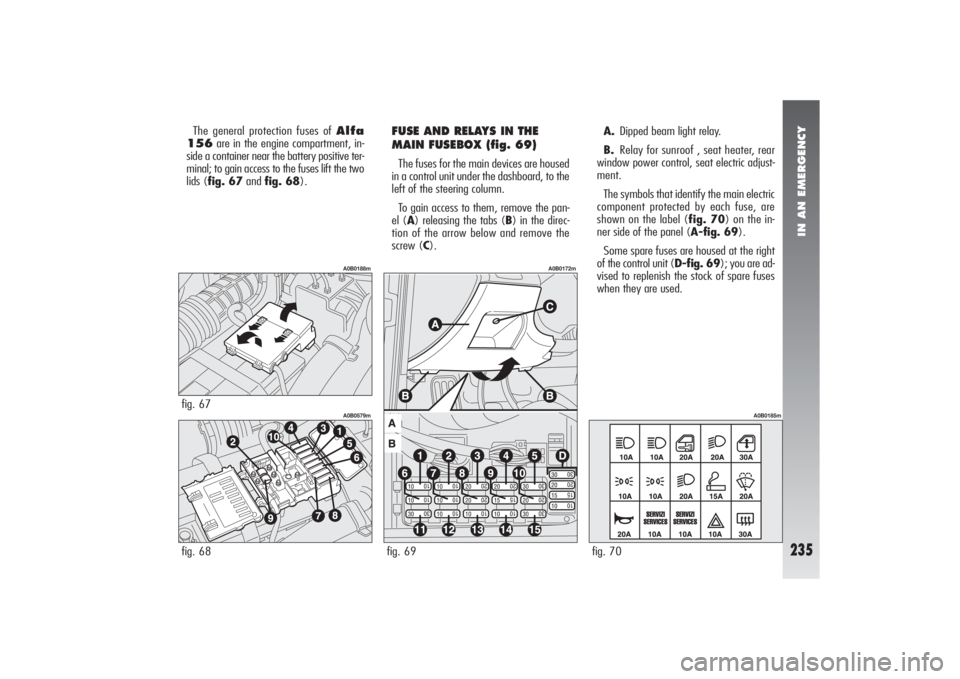
IN AN EMERGENCY
235
The general protection fuses of Alfa
156are in the engine compartment, in-
side a container near the battery positive ter-
minal; to gain access to the fuses lift the two
lids (fig. 67and fig. 68).
FUSE AND RELAYS IN THE
MAIN FUSEBOX (fig. 69)The fuses for the main devices are housed
in a control unit under the dashboard, to the
left of the steering column.
To gain access to them, remove the pan-
el (A) releasing the tabs (B) in the direc-
tion of the arrow below and remove the
screw (C).A.Dipped beam light relay.
B.Relay for sunroof , seat heater, rear
window power control, seat electric adjust-
ment.
The symbols that identify the main electric
component protected by each fuse, are
shown on the label (fig. 70) on the in-
ner side of the panel (A-fig. 69).
Some spare fuses are housed at the right
of the control unit (D-fig. 69); you are ad-
vised to replenish the stock of spare fuses
when they are used.
fig. 68
A0B0579m
fig. 67
A0B0188m
fig. 69
A0B0172m
fig. 70
A0B0185m
Page 241 of 357
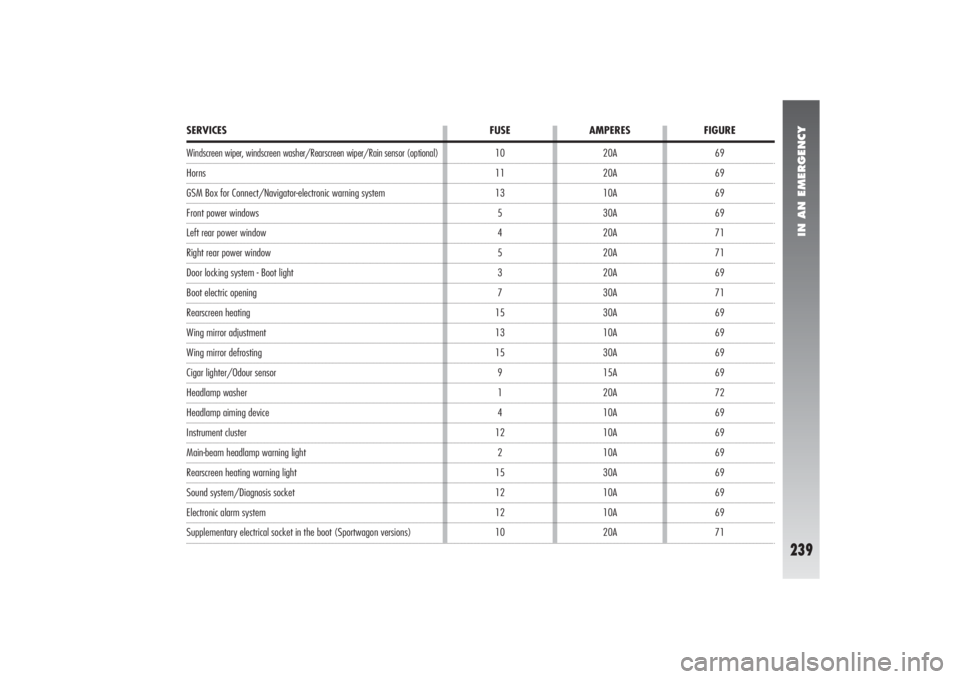
IN AN EMERGENCY
239
69
69
69
69
71
71
69
71
69
69
69
69
72
69
69
69
69
69
69
71 10
11
13
5
4
5
3
7
15
13
15
9
1
4
12
2
15
12
12
10
SERVICES FUSE AMPERES FIGUREWindscreen wiper, windscreen washer/Rearscreen wiper/Rain sensor (optional)HornsGSM Box for Connect/Navigator-electronic warning systemFront power windowsLeft rear power windowRight rear power windowDoor locking system - Boot lightBoot electric openingRearscreen heatingWing mirror adjustmentWing mirror defrostingCigar lighter/Odour sensorHeadlamp washerHeadlamp aiming deviceInstrument clusterMain-beam headlamp warning lightRearscreen heating warning lightSound system/Diagnosis socketElectronic alarm system Supplementary electrical socket in the boot (Sportwagon versions)20A
20A
10A
30A
20A
20A
20A
30A
30A
10A
30A
15A
20A
10A
10A
10A
30A
10A
10A
20A
Page 248 of 357

IN AN EMERGENCY
246
IF AN ACCIDENT
OCCURS– It is important to keep calm.
– If you are not directly involved in the ac-
cident, stop at least ten metres away from
the accident.
– If you are on a motorway do not ob-
struct the emergency lane with your car.
– Turn off the engine and turn on the haz-
ard lights.
– At night, illuminate the scene of the ac-
cident with your headlights.– Act carefully, you must not risk being run
over.
– Mark the accident by putting the red tri-
angle at the regulatory distance from the car
where it can be clearly seen.
– Call the emergency services making the
information you give as accurate as you can.
On the motorway use the special column-
mounted emergency phones.
– In pile-ups on the motorway, particular-
ly when the visibility is bad, there is a high
risk of other vehicles running into those al-
ready immobile. Get out of the vehicle im-
mediately and take refuge behind the guard
rail.
– If the doors are blocked, do not try to
get out of the vehicle by breaking the strat-
ified windscreen. The rear and side windows
are easier to break.
– Remove the ignition keys of the vehi-
cles involved.– If you smell petrol or other chemicals,
do not smoke and make sure all cigarettes
are extinguished.
– Use a fire extinguisher, blanket, sand or
earth to put out fires, no matter how small
they are. Never use water.
– If it is not necessary to use the lighting
system, disconnect the terminal from the
battery negative (–) pole.
Page 268 of 357

CAR MAINTENANCE
266
BATTERYThe battery is of the “Limited Mainte-
nance” type and is fitted with an optical in-
dicator (A-fig. 23) for checking the elec-
trolyte level and charge.
Under normal conditions of use the elec-
trolyte does not need topping up with dis-
tilled water. To make sure that it is in effi-
cient conditions, at routine intervals check
the indicator on the battery cover which
should be dark in colour with a green cen-
tral area.
If the indicator is a bright light colour, or
dark without the green central area, contact
Alfa Romeo Authorized Services.Batteries contain sub-
stances that are very
harmful for the environ-
ment. You are advised to have the
battery changed at Alfa Romeo
Authorized Services, which are
properly equipped for disposing of
used batteries respecting nature
and the law.
POLLEN FILTER This has mechanical/electrostatic air fil-
tering actions, provided that the windows
and doors are shut.
Have the pollen filter checked once a year
by Alfa Romeo Authorized Services, prefer-
ably at the onset of summer.
If the car is mainly used in dusty or heav-
ily polluted areas, the filter should be
changed at more frequent intervals than
specified in the Scheduled Maintenance Pro-
gramme.
WARNINGThe failure to replace the fil-
ter can considerably reduce the effectiveness
of the climate control system.
fig. 23
A0B0147m
The liquid in the battery is
poisonous and corrosive.
Avoid contact with eyes and skin.
Do not bring naked flames or pos-
sible sources of sparks near to the
battery: risk of fire and explosion.
WARNING